Alpha helix - Study guides, Class notes & Summaries
Looking for the best study guides, study notes and summaries about Alpha helix? On this page you'll find 1240 study documents about Alpha helix.
Page 3 out of 1.240 results
Sort by
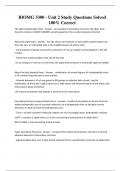
-
BIOMG 3300 - Unit 2 Study Questions Solved 100% Correct
- Exam (elaborations) • 11 pages • 2024
-
- $12.19
- + learn more
The right-handed alpha helix - Answer - An example of secondary structure; the alpha helix found in proteins is RIGHT-HANDED; spirals upwards in the counterclockwise direction About the alpha helix - Answer - AA side chains and H atoms on each alpha carbon project out from the axis; no noticeable hole in the middle because of atomic radii - intramolecular H bonds connect the carbonyl C of one aa residue to the peptide H in the 4th residue - H-bond are nearly parallel to the axis of the hel...
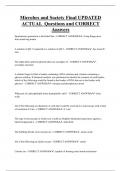
-
Microbes and Society Final UPDATED ACTUAL Questions and CORRECT Answers
- Exam (elaborations) • 37 pages • 2024
-
- $9.99
- + learn more
Microbes and Society Final UPDATED ACTUAL Questions and CORRECT Answers Spontaneous generation is the belief that - CORRECT ANSWER- living things arise from nonliving matter A solution of pH 7 compared to a solution of pH 9 - CORRECT ANSWER- has more H+ ions The alpha helix and beta pleated sheet are examples of - CORRECT ANSWER- secondary structure
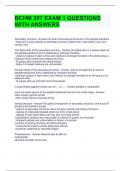
-
BCHM 307 EXAM 1 QUESTIONS WITH ANSWERS
- Exam (elaborations) • 9 pages • 2024
-
Available in package deal
-
- $12.49
- + learn more
BCHM 307 EXAM 1 QUESTIONS WITH ANSWERS Secondary structure - Answer-the local 3-dimensional structure of the peptide backbone - there are 4 major classes of secondary structure (alpha helix, beta sheet, turns, and random coil) The alpha helix of the secondary structure - Answer-the alpha helix is a helical region of the peptide backbone that is stabilized by hydrogen bonding - carbonyl residue of each amino acid residue is hydrogen bonded to the amide group 4 residues further toward the c...

-
BMSC 207 post midterm || A Verified A+ Pass.
- Exam (elaborations) • 18 pages • 2024
-
Available in package deal
-
- $12.79
- + learn more
Function of all muscles correct answers to generate force and movement Skeletal muscles correct answers - voluntary (somatic neurons) - striated - Multi-nucleated - insertion is more distal - antagonistic muscle groups = flexor-extensor pairs - 40% of body weight Cardiac Muscle correct answers - Primarily involuntary - striated and uninucleated - spontaneous electrical activity - altered by autonimc NS and hormones - intercalated disks that connects them - desmosomes (mechanica...
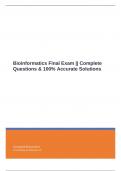
-
Bioinformatics Final Exam || Complete Questions & 100% Accurate Solutions
- Exam (elaborations) • 22 pages • 2024
-
Available in package deal
-
- $10.49
- + learn more
Bioinformatics Final Exam || Complete Questions & 100% Accurate Solutions Bioinformatics Final Exam || Complete Questions & 100% Accurate Solutions Bioinformatics - ANSWER - The technology that uses computers for storage, retrieval, manipulation and distribution of information related to biological macromolecules. (DNA, RNA, proteins, metabolites, lipids.) Who is the mother of bioinformatics? - ANSWER - Margaret Dayhoff What are the three main areas of bioinformatics? - ANSWER - - Mole...
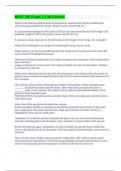
-
BIOC 385 Exam 1 || All Correct.
- Exam (elaborations) • 17 pages • 2024
-
Available in package deal
-
- $13.09
- + learn more
Which of the following differentiates the biochemical standard state from the standard state when discussing standard free energy changes? correct answers pH of 7 If a typical person hydrolyzes 100.0 mol of ATP per day, how much does this ATP weigh? (The molecular weight of ATP is 507 g/mol.) correct answers 50.7 kg A reaction is always spontaneous if correct answers the change in free energy, ΔG, is negative. Which of the following is an example of a heterotroph? correct answers yeast...

-
BIO 201 EXAM 1 ASU LATEST UPDATE 100% VERIFIED
- Exam (elaborations) • 22 pages • 2024
- Available in package deal
-
- $9.99
- + learn more
BIO 201 EXAM 1 ASU LATEST UPDATE 100% VERIFIED abdominal cavity contains the digestive system and stomach abdominal region below the diaphragm abdominopelvic cavity contains the abdomen and pelvis, two layered serous membrane called peritoneum acidic pH of 0; ex: lemon juice, gastric juice, vinegar adipose connective tissue nucleus on edge, variable sizes; energy reservoir, insulation, cushion; found in skin adult stem cell undifferentiated cells found in mature organs ...
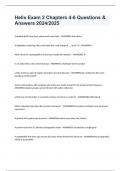
-
Helix Exam 2 Chapters 4-6 Questions & Answers 2024/2025
- Exam (elaborations) • 11 pages • 2024
-
Available in package deal
-
- $8.99
- + learn more
Helix Exam 2 Chapters 4-6 Questions & Answers 2024/2025 A peptide built from three amino acids must have - ANSWERS3 side chains A dipeptide containing valine and lysine has a net charge of __ at pH 7.0 - ANSWERS+1 Which bond in a polypeptide has the least rotational freedom? - ANSWERSC-N In an alpha helix, each carbonyl group - ANSWERSis a hydrogen bond acceptor a beta sheet is a type of regular secondary structure because - ANSWERSeach residue has the same backbone conformation...
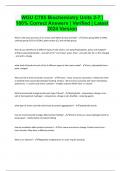
-
WGU C785 Biochemistry Units 2-7 | 100% Correct Answers | Verified | Latest 2024 Version
- Exam (elaborations) • 23 pages • 2024
- Available in package deal
-
- $13.49
- + learn more
What is the basic structure of an amino acid? What do they look like? - amino group (NH2 or NH3), carboxyl group (COO or COOH), alpha carbon (C), and variable group How do you identify the 3 different types of side chains: non-polar/hydrophobic, polar, and charged? - Non-polar/hydrophobic - end with CH or "can't have" water. Polar - end with OH, SH, or NH. Charged - end with a charge what kinds of bonds do each of the 3 different types of side chains make? - ionic, hydrophobic/nonpolar, ...
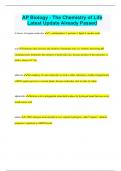
-
AP Biology - The Chemistry of Life Latest Update Already Passed
- Exam (elaborations) • 19 pages • 2024
- Available in package deal
-
- $9.99
- + learn more
AP Biology - The Chemistry of Life Latest Update Already Passed 4 classes of organic molecules 1. carbohydrates 2. proteins 3. lipids 4. nucleic acids acid substance that increases the molarity of hydrogen ions in a solution, decreasing pH (simultaneously diminishes the molarity of hydroxide ions, because product of the molarities of both is always 10^-14) adhesion the tendency of water molecules to stick to other substances; enables transportation of H2O against gravity in vascular...

$6.50 for your textbook summary multiplied by 100 fellow students... Do the math: that's a lot of money! Don't be a thief of your own wallet and start uploading yours now. Discover all about earning on Stuvia


